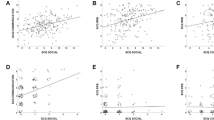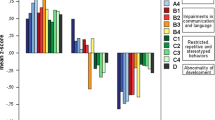Abstract
The classification of autism spectrum disorders (ASDs) is a topic of debate among clinicians and researchers with many questioning the validity of the distinction among subtypes. This manuscript examines the validity of three ASD subtypes (Autism, Asperger’s, and PDDNOS) by reviewing 22 studies published between 1994 and 2006. We reviewed studies that examined differences between the subtypes in terms of clinical and demographic characteristics, neuropsychological profiles, comorbidity, and prognosis. Results largely did not support differences between autism and Asperger’s disorder based on current diagnostic criteria. Overall, the most salient group differences were noted when samples were categorized on IQ. Drawing definitive conclusions is difficult due to the inconsistent application of diagnostic criteria and circularity in methods.
Access this article
We’re sorry, something doesn't seem to be working properly.
Please try refreshing the page. If that doesn't work, please contact support so we can address the problem.
Similar content being viewed by others
Explore related subjects
Discover the latest articles and news from researchers in related subjects, suggested using machine learning.References
American Psychiatric Association. (1980). Diagnostic and statistical manual of mental disorders (3rd ed.). Washington: American Psychiatric Association.
American Psychiatric Association. (1994). Diagnostic and statistical manual of mental disorders (4th ed.). Washington: American Psychiatric Association.
American Psychiatric Association. (2000). Diagnostic and statistical manual of mental disorders (4th ed., text revisions). Washington: American Psychiatric Association.
Asperger, H. (1944). Die ‘Autistischen Psychopathen’ im Kindesalter. Archiv für Psychiatrie und Nervenkrankheiten, 117, 76–136.
Billstedt, E., Gillberg, C., & Gillberg, C. (2005). Autism after adolescence: Population-based 13- to 22-year follow-up study of 120 individuals with autism diagnosed in childhood. Journal of Autism and Developmental Disorders, 35, 351–360.
Borden, M. C., & Ollendick, T. H. (1994). An examination of the validity of social subtypes in autism. Journal of Autism and Developmental Disorders, 24, 23–37.
Buitelaar, J. K., Van der Gaag, R., Klin, A., & Volkmar, F. (1999). Exploring the boundaries of pervasive developmental disorder not otherwise specified: Analyses of data from the DSM-IV autistic disorder field trials. Journal of Autism and Developmental Disorders, 29, 33–43.
Cantwell, D. P. (1996). Classification of child and adolescent psychopathology. Journal of Child Psychology and Psychiatry, 37, 3–12.
Chakrabarti, S., & Fombonne, E. (2001). Pervasive developmental disorders in preschool children. Journal of the American Medical Association, 285, 3093–3099.
Chung, S. Y., Luk, S. L., & Lee, P. W. (1990). A follow-up study of infantile autism in Hong Kong. Journal of Autism and Developmental Disorders, 20, 221–232.
Clark, L. A., Watson, D., & Reynolds, S. (1995). Diagnosis and classification in psychopathology: Challenges to the current system and future directions. Annual Review of Psychology, 46, 121–153.
de Bruin, E. I., Verheij, F., & Ferdinand, R. F. (2006). WISC-R subtest but no overall VIQ-PIQ differences in Dutch children with PDD-NOS. Journal of Abnormal Child Psychology, 34, 254–262.
Gadow, K. D., DeVincent, C. J., Pomeroy, J., & Azizian, A. (2004). Psychiatric symptoms in preschool children with PDD and clinic and comparison samples. Journal of Autism and Developmental Disorders, 34, 379–393.
Gadow, K. D., DeVincent, C. J., Pomeroy, J., & Azizian, A. (2005). Comparison of DSM-IV symptoms in elementary school-aged children with PDD versus clinic and community samples. Autism, 9, 392–415.
Ghaziuddin, M. (2005). A family history study of Asperger syndrome. Journal of Autism and Developmental Disorders, 35, 177–182.
Ghaziuddin, M., & Gerstein, L. (1996). Pedantic speaking style differentiates Asperger syndrome from high-functioning autism. Journal of Autism and Developmental Disorders, 26, 585–595.
Ghaziuddin, M., & Mountain-Kimchi, K. (2004). Defining the intellectual profile of Asperger Syndrome: Comparison with high-functioning autism. Journal of Autism and Developmental Disorders, 34, 279–284.
Gupta, A. R., & State, M. W. (2007). Recent advances in the genetics of autism. Biological Psychiatry, 61, 429–437.
Harris, S. L., & Handleman, J. S. (2000). Age and IQ at intake as predictors of placement for young children with autism: A four- to six-year follow-up. Journal of Autism and Developmental Disorders, 30, 137–142.
Howlin, P. (2003). Outcome in high-functioning adults with autism with and without early language delays: Implications for the differentiation between autism and Asperger Syndrome. Journal of Autism and Developmental Disorders, 33, 3–13.
Iwanaga, R., Kawasaki, C., Tsuchida, R. (2000). Brief report: Comparison of sensory-motor and cognitive functioning between autism and Asperger Syndrome in preschool children. Journal of Autism and Developmental Disorders, 30, 169–174.
Joseph, R. M., Tager-Flusberg, H., & Lord, C. (2002). Cognitive profiles and social-communicative functioning in children with autism spectrum disorder. Journal of Child Psychology and Psychiatry, 43, 807–821.
Kanner, L. (1943). Autistic disturbances of affective contact. Nervous Child, 2, 217–250.
Kim, J. A., Szatmari, P., Bryson, S. E., Streiner, D. L., & Wilson, F. J. (2000). The prevalence of anxiety and mood problems among children with autism and Asperger syndrome. Autism, 4, 117–132.
Klin, A., Pauls, D., Schultz, R., & Volkmar, F. (2005). Three diagnostic approaches to Asperger Syndrome: Implications for research. Journal of Autism and Developmental Disorders, 35, 221–234.
Klin, A., Volkmar, F. R., Sparrow, S. S., Cicchetti, D. V., & Rourke, B. P. (1995). Validity and neuropsychological characterization of Asperger Syndrome: Convergence with nonverbal learning disability syndrome. Journal of Child Psychology and Psychiatry, 36, 1127–1140.
Lecavalier, L. (2006). Behavior and emotional problems in young people with pervasive developmental disorders: Relative prevalence, effects of subject characteristics, and empirical classification. Journal of Autism and Developmental Disorders, 36, 1101–1114.
Lord, C., Leventhal, B. L., & Cook, E. H. (2001). Quantifying the phenotype in autism spectrum disorders. Neuropsychiatric Genetics, 105, 36–38.
Lord, C., Risi, S., DiLavore, P., Shulman, C., Thurm, A., & Pickles, A. (2006). Autism from 2 to 9 years of age. Archives of General Psychiatry, 63, 694–701.
Lord, C., Risi, S., Lambrecht, L., Leventhal, B. L., DiLavore, P., Pickles, A., et al. (2000). The autism diagnostic observation schedule-generic: A standard measure of social and communication deficits associated with the spectrum of autism. Journal of Autism and Developmental Disorders, 30, 205–223.
Macintosh, K., & Dissanayake, C. (2004). Annotation. The similarities and differences between autistic disorder and Asperger’s disorder: A review of the empirical evidence. Journal of Child Psychology and Psychiatry, 45, 421–434.
Mahoney, W. J., Szatmari, P., MacLean, J. E., Bryson, S. E., Jones, M. B., & Zwaigenbaum, L. (1998). Reliability and accuracy of differentiating pervasive developmental disorder subtypes. Journal of the American Academy of Child and Adolescent Psychiatry, 37, 278–285.
Militerni, R., Bravaccio, C., Falco, C., Fico, C., & Palermo, M. T. (2002). Repetitive behaviors in autistic disorder. Journal European Child & Adolescent Psychiatry, 11, 210–218.
Miller, J. N., & Ozonoff, S. (2000). The external validity of Asperger disorder: Lack of evidence from the domain of neuropsychology. Journal of Abnormal Psychology, 109, 227–238.
Muhle, R., Trentacoste, S., & Rapin, I. (2004). The genetics of autism. Pediatrics, 113, 472–486.
Ozonoff, S. (1998). Assessment and remediation of executive dysfunction in autism, Asperger syndrome. In E. Schopler & G. B. Mesibov (Eds.), Asperger syndrome or high-functioning autism? (pp. 11–28). New York: Plenum Press.
Ozonoff, S., South, M., & Miller, J. N. (2000). DSM-IV-defined Asperger syndrome: Cognitive, behavioral and early history differentiation from high-functioning autism. Autism, 4, 29–46.
Robins, E., & Guze, S. B. (1970). Establishment of diagnostic validity in psychiatric illness: Its application to schizophrenia. American Journal of Psychiatry, 126, 983–987.
Rutter, M. (1978). Diagnostic validity in child psychiatry. Advances in Biological Psychiatry, 2, 2–22.
Rutter, M., Le Couteur, A., & Lord, C. (2003). Autism diagnostic interview-revised. Los Angeles: Western Psychological Services.
South, M., Ozonoff, S., & McMahon, W. M. (2005). Repetitive behavior profiles in Asperger syndrome and high-functioning autism. Journal of Autism and Developmental Disorders, 35, 145–158.
Sponheim, E., & Skejeldal, O. (1998). Autism and related disorders: Epidemiological findings in a Norwegian study using ICD-10 diagnostic criteria. Journal of Autism and Developmental Disorders, 28, 217–227.
Szatmari, P., Archer, L., Fisman, S., Streiner, D. L., & Wilson, F. (1995). Asperger’s syndrome and autism: Differences in behavior, cognition, and adaptive functioning. Journal of the American Academy of Child and Adolescent Psychiatry, 34, 1662–1671.
Szatmari, P., Bryson, S. E., Streiner, D. L., Wilson, F., Archer, L., & Ryerse, C. (2000a). Two-year outcome of preschool children with autism of Asperger’s disorder. American Journal of Psychiatry, 157, 1980–1987.
Szatmari, P., Merette, C., Bryson, S. E., Thivierge, J., Roy, M., Cayer, M., & Maziade, M. (2000b). Quantifying dimensions in autism: A factor-analytic study. Journal of the American Academy of Child & Adolescent Psychiatry, 41, 467–474.
Tonge, B. J., Brereton, A. V., Gray, K. M., & Einfeld, S. L. (1999). Behavioural and emotional disturbance in high-functioning autism and Asperger syndrome. Autism, 3, 117–130.
Towbin, K. E. (2005). Pervasive developmental disorder not otherwise specified. In F. R. Volkmar, R. Paul, A. Klin, & D. Cohen (Eds.), Handbook of autism and pervasive developmental disorders Vol. 1: Diagnosis, development, neurobiology, and behavior (3rd ed., pp. 165–200). Hoboken: Wiley.
Verte, S., Geurts, H. M., Roeyers, H., Oosterlaan, J., & Sergeant, J. A. (2006a). Executive functioning in children with an autism spectrum disorder: Can we differentiate within the spectrum? Journal of Autism and Developmental Disorder, 36, 351–372.
Verte, S., Geurts, H. M., Roeyers, H., Rosseel, Y., Oosterlaan, J., & Sergeant, J. A. (2006b). Can the children’s communication checklist differentiate autism spectrum subtypes? Autism, 10, 266–287.
Volkmar, F. R. (1998). Categorical approaches to the diagnosis of autism. Autism, 2, 45–49.
Volkmar, F. R., & Klin, A. (2005). Issues in the classification of autism, related conditions. In F. R. Volkmar, R. Paul, A. Klin, & D. Cohen (Eds.), Handbook of autism and pervasive developmental disorders Vol. 1: Diagnosis, development, neurobiology, and behavior (3rd ed., pp. 5–41). Hoboken: Wiley.
Volkmar, F. R., Klin, A., Siegel, B., Szatmari, P., Lord, C., Campbell, M., et al. (1994). Field trial for autistic disorder in DSM-IV. American Journal of Psychiatry, 151, 1361–1367.
Volkmar, F. R., Lord, C., Bailey, A., Schultz, R. T., & Klin, A. (2004). Autism and pervasive developmental disorders. Journal of Child Psychology and Psychiatry, 45, 135–170.
Walker, D. R., Thompson, A., Zwaigenbaum, L., Goldberg, J., Bryson, S., Mahoney, W. J., Strawbridge, C. P., & Szatmari, P. (2004). Specifying PDD-NOS: A comparison of PDD-NOS, Asperger syndrome, and autism. Journal of the American Academy of Child and Adolescent Psychiatry, 43, 172–180.
Weisbrot, D. M., Gadow, K. D., DeVincent, C. J., & Pomeroy, J. (2005). The presentation of anxiety in children with pervasive developmental disorders. Journal of Child and Adolescent Psychopharmacology, 15, 477–496.
Wing, L. (1981). Asperger’s syndrome: A clinical account. Psychological Medicine, 11, 115–129.
Wing, L. (1998). The history of Asperger syndrome. In E. Schopler & G. B. Mesibov (Eds.), Asperger syndrome or high-functioning autism? (pp. 11–28). New York: Plenum Press.
World Health Organization. (1993). The ICD-10 classification of mental and behavioural disorders: Diagnostic criteria for research. Geneva: World Health Organization.
Author information
Authors and Affiliations
Corresponding author
Rights and permissions
About this article
Cite this article
Witwer, A.N., Lecavalier, L. Examining the Validity of Autism Spectrum Disorder Subtypes. J Autism Dev Disord 38, 1611–1624 (2008). https://doi.org/10.1007/s10803-008-0541-2
Received:
Accepted:
Published:
Issue Date:
DOI: https://doi.org/10.1007/s10803-008-0541-2




